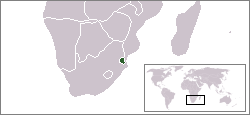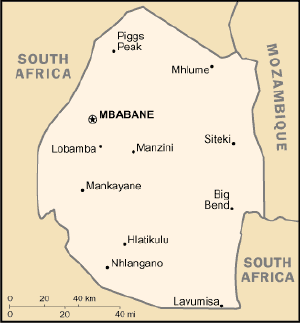Swaziland
The Kingdom of Swaziland, one of the smallest countries in Africa, is situated on the eastern slope of the Drakensberg mountains, embedded between South Africa in the west and Mozambique in the east. It is ruled autocratically by sub-Saharan Africa's last absolute monarch, who lives lavishly while two-thirds of the people survive on less than two dollars a day, largely from agriculture. Political parties and demonstrations are banned. The prevalence rate of HIV/AIDS is the highest in the world.
| |||||
| National motto: Siyinqaba (We Are the Fortress) | |||||

| |||||
| Principal languages | Swati, English | ||||
| Capitals | Mbabane (administrative) Lobamba (royal and legislative) | ||||
| King | Mswati III | ||||
| Prime minister | Themba Dlamini | ||||
| Area - Total - % water |
Ranked 153rd 17,363 km² 0.9% | ||||
| Population - Total (2001) - Density |
Ranked 150th 1,173,900 65/km² | ||||
| Independence | 1968 | ||||
| Currency | Lilangeni | ||||
| Time zone | Universal Time + 2 | ||||
| National anthem | Nkulunkulu Mnikati wetibusiso temaSwati (O Lord, Our God, Bestower of Blessings upon the Swazi) | ||||
| Internet TLD | .sz | ||||
| Country calling code | 268 | ||||
History
Human remains and artifacts from more than 100,000 years ago have been found in Swaziland. Evidence of agriculture and iron use dates from about the fourth century, and people speaking languages ancestral to current Sotho and Nguni languages began settling no later than the eleventh century.
According to tradition, the people of the present Swazi nation descend from the southern Bantu who migrated south from central Africa in the fifteenth and sixteenth centuries to what is now Mozambique. Following a series of conflicts with people living in the area of modern Maputo, the Swazis settled in northern Zululand about 1750. Unable to match the growing Zulu strength, the Swazis moved gradually northward in the 1800s and established themselves in the area of modern Swaziland. As the Zulu raids of the early nineteenth century, known as the mfecane or difaqane, dispersed surrounding tribes, the arrival of the Ngwame provided the stimulus for the formation of the Swazi state.
They consolidated their hold under several able leaders. The most important was Mswati II, from whom the Swazis derive their name. Under his leadership in the 1840s, they expanded their territory to the northwest and stabilized the southern frontier with the Zulus. In self-defense, the Swazi adopted some of the military innovations that had empowered the Zulus.
Early in Mswati's reign he asked British authorities in South Africa for assistance against Zulu raids into Swaziland. It also was during Mswati's reign that the first whites settled in the country as the Boers moved north to avoid British rule. Following Mswati's death, the Swazis reached agreements with British and South African authorities over a range of issues, including independence, claims on resources by Europeans, administrative authority, and security. South Africans administered Swazi interests from 1894 to 1902. In 1902 Swaziland became a British protectorate and thus maintained its teritorial identity.
In the early years of colonial rule, the British had expected that Swaziland would eventually be incorporated into South Africa. After World War II, however, South Africa's intensification of racial discrimination induced the United Kingdom to prepare Swaziland for independence. Political activity intensified in the early 1960s, but the largely urban parties had few ties to the rural areas, where the majority of Swazis lived.
The country was granted independence on September 6, 1968. Since then, Swaziland has seen a struggle between pro-democracy activists and the totalitarian monarchy. All political parties are banned.
In 2007, the Coordinating Assembly of Non-Governmental Organizations (CANGO) listed the problems facing the nation as poverty, HIV/AIDS, food security, governance, employment, corruption, and gender-based violence. It complained that the government's failure to respect the nation's NGOs was hindering their ability to address the nation's humanitarian crisis and called for fiscal transparency and accountability and a shift in spending priorities to allocate more funds for education and health. CANGO said donors were avoiding Swaziland because of its lack of democratic reforms and transparency.
Politics
The head of state is the king, who since 1986 has been King Mswati III. By tradition, the king holds supreme executive, legislative, and judicial powers. The king not only appoints the prime minister — the head of government — but also a small number of representatives for both chambers of the Libandla (parliament). The Senate consists of thirty members, while the House of Assembly has sixty-five seats, fifty-five of which are occupied by elected representatives, but since political parties are banned, they run as individuals.
The 1968 constitution was suspended in 1973. In 2001 King Mswati III appointed a committee to draft a new constitution. It was signed by the king in July 2005 after sections he objected to had been changed. The new constitution reaffirms his authority over the government and legislature and was strongly criticized by civil society organizations in Swaziland and human rights organizations elsewhere. It went into effect in 2006, the first constitution in over thirty years.
King Mswati III is often criticized for living lavishly in a nation that is afflicted by the world's highest HIV infection rate. His fleet of luxury cars and millions spent on refurbishing his numerous wives' luxury mansions are at odds with the approximately 34 percent of the nation that stand unemployed, nearly 70 percent of whom live on less than a dollar a day, and with around 39 percent of adults afflicted by HIV.
Economy
In this small, landlocked economy, subsistence agriculture or livestock herding occupy more than 80 percent of the population. Most of the land is held in trust for the nation by the monarchy. The manufacturing sector has diversified since the mid-1980s. Sugar and wood pulp remain important foreign exchange earners. Mining has declined in importance in recent years, with only coal and quarry stone mines remaining active.
Surrounded by South Africa, except for a short border with Mozambique, Swaziland is heavily dependent on South Africa, from which it receives nine-tenths of its imports and to which it sends more than two-thirds of its exports. Customs duties from the Southern African Customs Union and worker remittances from South Africa substantially supplement domestically earned income. But the customs fees will be lost when regional trade reforms take effect. To compensate, the government is trying to build up the transportation and tourism sectors.
It is also trying to improve the atmosphere for foreign investment. But even the textile factories built to take advantage of special benefits moved on to China and India with the removal of import quotas on textiles. The prime minister predicted a growth rate of 2.8 percent for 2006; critics doubted that was realistic. The Central Bank of Swaziland said at least 2.9 percent economic growth was needed to match population growth and maintain Swazis' standard of living.
Overgrazing, soil depletion, drought, and sometimes floods persist as problems for the future. In 2004 Swaziland acknowledged for the first time that it has one of the highest AIDS rates in the world, with almost 40 percent of adults infected with HIV. Prime Minister Themba Dlamini declared a humanitarian crisis due to the combined effect of drought and land degradation, increasing poverty, and HIV/AIDS. The United Nations special envoy on AIDS, Stephen Lewis, said “Swaziland stands alone with the world's highest rate of HIV infection after nearby Botswana made headway against the deadly pandemic.”
Geography
Swaziland offers a wide variety of landscapes, from the mountains along the Mozambican border to savannas in the east and rainforest in the northwest. Several rivers flow through the country, such as the Lusutfu River. With fifty thousand inhabitants, the capital city of Mbabane is the largest town in the nation; others include Manzini, Lobamba, and Siteki.
Demographics
The majority of the population consists of Swazi, but there are also small numbers of Zulus, Europeans, and Mozambican refugees. The official languages are Swati and English; the latter is also the official written language. The chief religion is Christianity, often in a form blended with several indigenous religions. There are also Jewish and Muslim communities.
Culture
ReferencesISBN links support NWE through referral fees
- James L. Newman, The Peopling of Africa, 1995. Yale University Press, New Haven, CT. ISBN 0300060033
- Paul Bohannan and Philip Curtin, Africa and Africans, 3rd ed., 1988. Waveland Press, Prospect Heights, IL. ISBN 0881333476
- Charles H. Cutter, Africa 2006, 41st ed., 2006. Stryker-Post Publications, Harpers Ferry, WV. ISBN 1887985727
- Marq de Villiers and Sheila Hirtle, Into Africa, 1997. Key Porter Books, Toronto, Canada. ISBN 1550138847
- "'Weak' Civil Society Hampering Efforts to Address Crises" allAfrica - Swaziland, observed January 26, 2007.
- "Prime Minister Upbeat About Country's Prospects" allAfrica - Swaziland, observed January 26, 2007.
External Links
Government
- Swaziland Government official government site
- Ministry of Tourism official site
News
- allAfrica - Swaziland news headline links
- Times of Swaziland newspaper
Credits
New World Encyclopedia writers and editors rewrote and completed the Wikipedia article in accordance with New World Encyclopedia standards. This article abides by terms of the Creative Commons CC-by-sa 3.0 License (CC-by-sa), which may be used and disseminated with proper attribution. Credit is due under the terms of this license that can reference both the New World Encyclopedia contributors and the selfless volunteer contributors of the Wikimedia Foundation. To cite this article click here for a list of acceptable citing formats.The history of earlier contributions by wikipedians is accessible to researchers here:
The history of this article since it was imported to New World Encyclopedia:
Note: Some restrictions may apply to use of individual images which are separately licensed.
